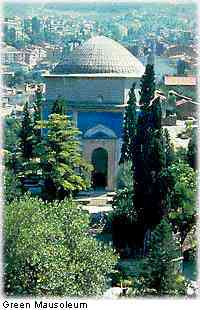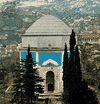

BURSA
 Known as
"Green Bursa", this province stands on the lower slopes of Uludag
(Mount Olympos of Mysia, 2543 m). The title "Green" of Bursa comes
from its gardens and parks, and of course from its being in the middle of an
important fruit growing region. In Bursa there are things you should not miss.
First of all you are in the homeland of the delicious "Iskender Kebap".
The candied chestnuts are a specialty and have an unforgettable taste. The
peaches of Bursa are unique. As for something to purchase; Bursa is a center of
the silk trade and towel manufacturing. It is also the homeland of the very
famous Turkish folklore figures, Karagoz and Hacivat.
Known as
"Green Bursa", this province stands on the lower slopes of Uludag
(Mount Olympos of Mysia, 2543 m). The title "Green" of Bursa comes
from its gardens and parks, and of course from its being in the middle of an
important fruit growing region. In Bursa there are things you should not miss.
First of all you are in the homeland of the delicious "Iskender Kebap".
The candied chestnuts are a specialty and have an unforgettable taste. The
peaches of Bursa are unique. As for something to purchase; Bursa is a center of
the silk trade and towel manufacturing. It is also the homeland of the very
famous Turkish folklore figures, Karagoz and Hacivat.
Because of its being the first Ottoman capital, Bursa is very rich in religious monuments, mosques, and tombs (turbes), baths. One of the places to be seen in Bursa is the Yesil Mosque (Green Mosque), with its carved marble doorway which is one of the best in Anatolia. It is an elaborate and significant building in the new Turkish style. Just opposite, is the Yesil Tomb "Green Tomb", set in a green garden with an enchanting exterior decorated with turquoise tiles. Near the tomb, the Medresse complements the others and makes this the "green" trio, now it houses the Ethnographical Museum which certainly deserves visiting. The Yildirim Beyazit Mosque is important as it is the first one built in the new Ottoman style and is accompanied by the Emir Sultan Mosque which lies in a peaceful setting. The province is decorated with these monuments-each of which is a masterpiece. Here are the Ulu Mosque built in the Seljuk style, with impressive calligraphic wall decorations; the Orhan Gazi Mosque; the "Hisar" an attractive part of the province, and in the park the Mausoleums of Osman, the founder of the Ottoman Empire, and his son Orhan Gazi. The Muradiye Complex has a delightful view with its mosque and tombs of important characters from the Ottoman era and their tiles and charming decorations appeal to the sightseers. The Ottoman Museum offers a lively exhibit of the traditional life style of Ottomans.
Something you will enjoy in Bursa are the warm, mineral-rich springs; indeed most of the hotels in this province have thermal bath facilities. The Turkish baths "hamam" are great places which should be visited in Bursa. The Eski Kaplica (Old Spring) is the oldest in the province. The Karamustafa Pasha Baths are famous, and boast the best hot, mineral waters.
As for souvenirs, you should visit the Covered Bazaar, "Bedesten", or the Koza Han-an attractive building and also a center of silk trade. It is certain that Bursa will take some of time for you to see and add some more delightful experiences to your memories.
Environs:
Uludag is the largest and most celebrated winter-sports center in Turkey. It is 36 kms from Bursa and easily accessible by car or cable-car (teleferik). The area is also a national park and is worth a visit at any time of the year. The accommodation is high quality offering the opportunity to enjoy, with a variety of entertainment and sports activities.
Mudanya is a seaside resort town from fine fish restaurants and night-clubs there so you can have a pleasant
Zeytinbagi (Trilye) is a town of typical Turkish architecture and lay out. There are sea bus and ferry connections with Istanbul.
Gemlik (27 km north), is another seaside resort with a wide, sandy beach.
Iznik (Nicaea) lies 85 kms northeast of Bursa, at the eastern tip of Lake knik. The town has witnessed many civilizations which have left their marks all over the land. This town is famous for its unique tiles and has been the center of tile production in the 16th century. Iznik tiles were the basic decorative element of Seljuk and Ottoman architecture. The turquoise-tiled Yesil Mosque and Nilufer Hatun imareti are among the Islamic works in the town
 |
| Yesil Mausoleum, Bursa, Tur., built by Sultan Mehmed I, 1421 |
Set among orchards watered by plentiful mountain streams, Bursa is a city of brightly coloured houses and winding streets dotted with fountains. It retains its Ottoman flavour and contains some of the outstanding examples of Ottoman architecture. Among its mosques, Ulu Mosque (1421) is a vast building with 20 domes, noted for the variety and fineness of its calligraphic ornamentation. Yesil Mosque (1421) marked the beginning of a purely Turkish style; it includes a theological college, library, and ablution fountain. Nearby is the Yesil Mausoleum, containing the tomb of Sultan Mehmed I. The Muradiye Mosque (15th century) is surrounded by the tombs of sultans and their families. On a terrace overlooking the city are the tombs of Osman I, founder of the Ottoman dynasty, and his son Orhan. A 15th-century theological school houses the city's archaeological museum. Bursa's several baths, fed by thermal springs famous in Roman times, include medieval structures that incorporated material from Justinian's imperial baths from the 6th century.
Bursa's silk industry has a long heritage; the city was a centre of silk trade in the 15th century and by the 17th century was famous in Europe and Asia for its silk textiles, which are still produced. Other industries include cotton and woolen textiles, canned foods and dairy products, and machinery. Bursa is the site of Bursa University (1975) and is linked by air with Istanbul. It has long been a favourite tourist centre. Pop. (1985) 612,510.
![]()
Home | Ana
Sayfa | All About Turkey | Turkiye
hakkindaki Hersey | Turkish Road Map
| Historical Places in Adiyaman | Historical
Places in Turkey | Mt.Nemrut | Slide
Shows | Related Links | Guest
Book | Disclaimer | Send a Postcard | Travelers' Stories | Donate a little to help | Getting Around Istanbul | Adiyaman Forum
|
|